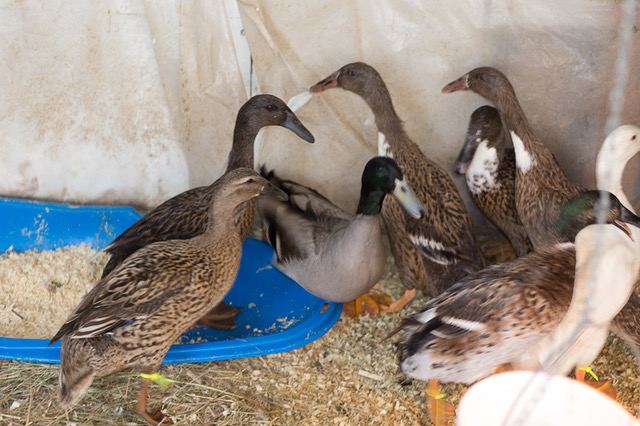Endangered Duck Breeds
We raise six endangered breeds of ducks. Fertile eggs for hatching are available from time to time. We hatch some ducklings. They are available for local pick up only. We ship fertile eggs but not ducklings.

Dutch Hookbills are critically endangered. In 2018, we learned that David Holderread, of Holderread Waterfowl Farm, was retiring and disposing of all his ducks. We purchased 8 of his few remaining adult Dutch Hookbills. As of 2019, we believe we are the only farm in the U.S. breeding them and providing fertilized eggs to other farms. They likely originated in the Netherlands in the 16th — 17th Century. The bill is downwardly curved, hence the name. Excellent foragers, they are smaller than our other breeds, quiet and remarkably varied in feather pattern. By 1980, a Dutch fellow rescued the last 15 ducks and in 2000, David Holderread imported a few to the U.S., bred them and sold them to farms like ours. The story is that farmers in the Netherlands let their ducks forage in wetlands. Hunters harvesting wild ducks recognized the “hooked” bill as a domestic duck and avoided shooting them. This seems impractical but who knows?
The Cayuga may be the only duck breed developed in the U.S. Their history is not clear but were probably domesticated from wild ducks. They may also be a breed in Great Britain referred to as the English black duck found in Lancashire in the 1800’s. An all black duck sounds aesthetically boring but they are absolutely beautiful with glossy black feathers. As they age, they develop lots of white markings against the black feathers. They are the hardiest of domestic ducks and easily tamed – a great thing for backyard duck owners with small children. They aren’t prolific layers but their eggs are really big.
Buff Orpington originated in Orpington, Kent, England. Poultry breeder William Cook created several color varieties of the Orpington crossing several existing breeds. First imported to the U.S. in 1908, these are a delicately colored and quite beautiful duck. They are large in size, and used as a meat and egg laying bird. In the early 20th Century, the buff color was quite popular in England and helped to promote the breed. Not for long, however, as commercial duck breeders moving to meat birds, weren’t interested in dual purpose ducks. A number of breeders in the U.S. and Great Britain are maintaining the original Orpington.
The Welsh Harlequin were developed in 1949 in Great Britain by a duck breeder who selected for light colored ducks from her Khaki Campbell ducks. Welsh Harlequin are relatively small, the males (drakes) look like the wild Mallard. They are excellent layers producing nearly as many eggs as Khaki Campbells. They were first imported to the U.S. in 1980.
Khaki Campbell were developed in the late 1800’s by Adele Campbell of Gloucestershire, England. The Khaki is the least endangered breed of those we raise and one of the world’s most prolific egg layer. There is one commercial egg farmer in Maine raising Khaki’s. Adele Campbell developed this breed out of Indian Runner’s and Rouen and kept selecting for a light buff. She ended up with a color a lot like the standard British army uniform so named them Khaki Campbell. They do well in hot, humid or northern cold climates.
Magpie ducks were developed in the 1800’s. They are noted for their sharp plumage of mostly white with striking black markings, and their grazing ability, including insects. In climates where the nasty liver fluke parasite infects sheep and goats, the Magpie eliminates or reduces infestations. They will lay up to 300 eggs per year. They are described as “active” which translates to being easily spooked. It works pretty well to keep flighty ducks with calmer ducks.
